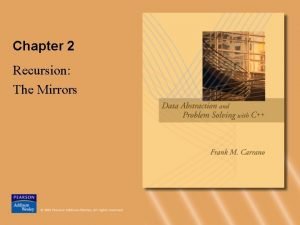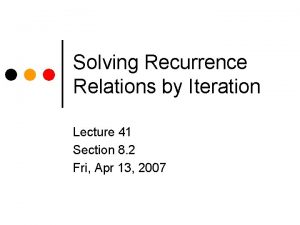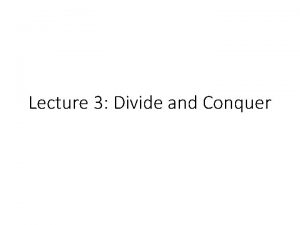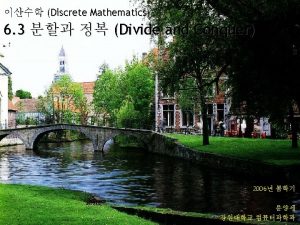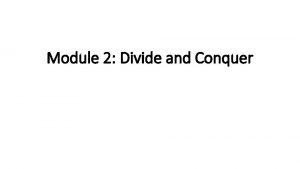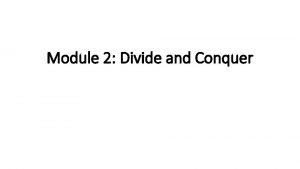Divide Conquer Recurrence Relations 6 3 Divide and










- Slides: 10


Divide & Conquer Recurrence Relations 6. 3 Divide and Conquer Main points so far: Many types of problems are solvable by reducing a problem of size n into some number a of independent subproblems, each of size n/b , where a 1 and b>1. (많은 경우에 있어서, 크기 n의 문제를 a개의 크기 n/b 의 작은 문제로 바꾸어 처리할 수 있다. ) The time complexity to solve such problems is given by a recurrence relation: T(n) = a·T( n/b ) + g(n) (이런 경우의 시간 복잡도는 T(n)의 점화 관계로 나타낼 수 있다. ) Time to break problem up into sub-problems Time for each sub-problem Page 2 Discrete Mathematics by Yang-Sae Moon

Divide & Conquer Examples 6. 3 Divide and Conquer Binary search: Break list into 1 sub-problem (smaller list) (so a=1) of size n/2 (so b=2). • So T(n) = T( n/2 )+c (g(n)=c constant) Merge sort: Break list of length n into 2 sub-lists (a=2), each of size n/2 (so b=2), then merge them, in g(n) = (n) time. • So T(n) = 2 T( n/2 ) + cn (roughly, for some c) Page 3 Discrete Mathematics by Yang-Sae Moon

Fast Multiplication Example (1/3) 6. 3 Divide and Conquer The ordinary grade-school algorithm takes (n 2) steps to multiply two n-digit numbers. (학교에서 배운 방법에 따르면, n자리인 두 수의 곱은 (n 2) 스텝이 필요하다. ) • This seems like too much work! So, let’s find a faster multiplication algorithm! To find the product cd of two 2 n-digit base-b numbers, c=(c 2 n-1 c 2 n-2…c 0)b and d=(d 2 n-1 d 2 n-2…d 0)b, first, we break c and d in half: c=bn. C 1+C 0, d=bn. D 1+D 0, (e. g. , 4321 = 102 43+21) and then. . . (see next slide) Page 4 Discrete Mathematics by Yang-Sae Moon

Fast Multiplication Example (2/3) 6. 3 Divide and Conquer Zero (Factor last polynomial) Three multiplications, each with n-digit numbers Page 5 Discrete Mathematics by Yang-Sae Moon

Fast Multiplication Example (3/3) 6. 3 Divide and Conquer Notice that the time complexity T(n) of the fast multiplication algorithm obeys the recurrence: T(2 n)=3 T(n)+ (n) Time to do the needed adds & subtracts of n-digit and 2 n-digit numbers i. e. , T(n)=3 T(n/2)+ (n) So a=3, b=2. ( The order will be reduced …) Page 6 Discrete Mathematics by Yang-Sae Moon

The Master Theorem 6. 3 Divide and Conquer Consider a function f(n) that, for all n=bk for all k Z+, satisfies the recurrence relation: (n=bk 일 때, 다음 점화 관계가 성립하면) f(n) = af(n/b) + cnd with a≥ 1, integer b>1, real c>0, d≥ 0. Then: Proof of theorem is …. omitted. Page 7 Discrete Mathematics by Yang-Sae Moon

Master Theorem Examples (1/3) 6. 3 Divide and Conquer Recall that complexity of fast multiplication was: T(n)=3 T(n/2)+ (n) Thus, a=3, b=2, d=1. So a > bd, so case 3 of the master theorem applies, so: which is O(n 1. 58…), so the new algorithm is strictly faster than ordinary (n 2) multiply! Page 8 Discrete Mathematics by Yang-Sae Moon


 The expression is a
The expression is a Rabbits and recurrence relations
Rabbits and recurrence relations Divide and conquer advantages and disadvantages
Divide and conquer advantages and disadvantages Top down greedy approach
Top down greedy approach Solving recurrence relations by iteration
Solving recurrence relations by iteration Linear homogeneous recurrence
Linear homogeneous recurrence Counting techniques in discrete mathematics
Counting techniques in discrete mathematics Delaunay triangulation divide and conquer algorithm
Delaunay triangulation divide and conquer algorithm Delaunay triangulation divide and conquer algorithm
Delaunay triangulation divide and conquer algorithm Counting inversions divide and conquer
Counting inversions divide and conquer Divide et impera c++ probleme rezolvate
Divide et impera c++ probleme rezolvate

